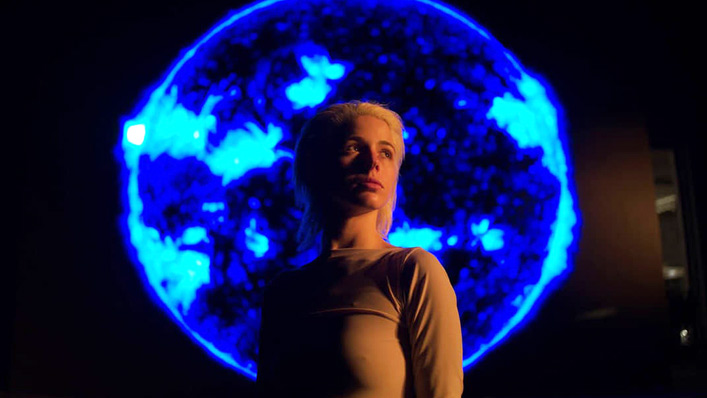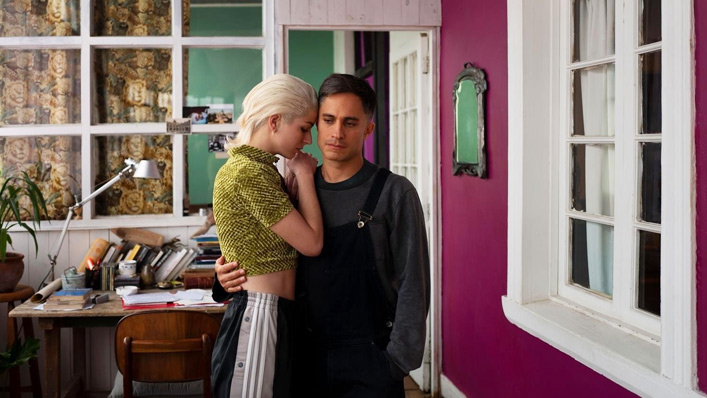Ema is a modern day twisted love/hate story with a killer soundtrack

The acclaimed music-infused Chilean drama Ema (now in cinemas) is worthy of its reputation, writes Cat Woods, with its profound comments on love, family, bodies, art and sex.
Chilean director Pablo Larrain’s film Ema leaves a cold chill in your bones for days—perhaps weeks—after seeing it. In its depiction of hugely flawed people, who love and destroy each other as if it’s all a game, it makes a profound statement on the darkness inherent in love, family, bodies, art and sex.
Mariana Di Girolama is the titular character, a professional reggaeton dancer whose sinuous movement, platinum hair and guileless face make her a brilliant and captivating dancer. She is wholly aware that those same assets are seductive tools to manipulate the men and women around her, which she does easily. The choreographer of the modern dance ensemble she performs in is her much older husband Gaston (the always impressive Gael Garcia Bernal), who lords his professional superiority over her during rehearsals and at home.

Neither of the lead characters are innocent
It appears, at first, that their relationship is easily explained in the historic cliché of an older power-hungry man manipulating his insecure, naive young wife. The question of who is manipulating who—and why—is never fully resolved and ultimately perhaps doesn’t matter, since neither of them are innocent of inflicting enormous pain.
Not least, upon a child, and that is where the bone-chilling element lies. It quickly becomes clear that something disastrous has happened, causing the couple to return their 12-year-old adopted son, Polo, to child services. Ema meets with a social worker alone and later is confronted at home by the same woman, who accuses the couple of being unfit parents, and Ema particularly, of not having the capacity to be a mother. Ema’s rebuke is that Gaston is infertile, unfit to be a father, a failure.
Bodies and music are at the heart of this movie
The sexuality of dance and the primal, savage connection between bodies is at the heart of this movie. The female members of the dance troupe are like a pack of wolves, moving as one both in performance and on the streets. They live together, sleep together, have sex with one another, vow to protect each other at all costs. And they do. They aid Ema in strapping a fuel tank to her back and setting out in the early hours of morning to set alight cars and traffic lights. She is monstrous in these moments, delighting in the devastation she’s causing.
The music—a furious percussive reggaeton beat—is the perfect soundtrack for Gaston, Emma and Polo’s downward spiral. Chilean-American composer Nicolas Jaar is known for his experimental attitude to dance music, having released several albums and prolific remixes. He is in his element here, unleashing clashing, confronting soundscapes that occasionally break into club-worthy, Caribbean dance epics accompanied by popping chests and deep squats.
It’s a sinister dance that both bonds Gaston and Ema and erodes their humanity. They suck other people into their black hole in a very twisted attempt to keep themselves entertained and from having to admit how enormously flawed they are.
A new take on Who’s Afraid of Virginia Woolf?
Though it may seem far-fetched, Larrain’s horror-dance flick bears similarities in theme to Edward Albee’s 1962 play Who’s Afraid of Virginia Woolf?, later made into a movie starring Richard Burton and Elizabeth Taylor as George and Martha. Though they snarl at one another, landing the most vicious, cruel accusations and observances, there is no question that they need one another. It is after a particularly drunken, argumentative night with George’s new workmate and his wife that Martha reflects:
“You know, there’s only been one man in my whole life that has ever made me happy. You know that? One. George, my husband…George, who is out somewhere there in the dark, who is good to me, and whom I revile, who can keep learning the games we play as quickly as I can change them…Whom I will not forgive for having seen me and having said, ‘Yes, this will do. Who has made the hideously hurting, the insulting mistake of loving me and must be punished for it.”

The malice and interdependence within George and Martha’s relationship in the classic play/movie “Who’s Afraid of Virginia Woolf” has parallels with the self-destructive relationship of Gaston and Ema. In both movies, despite how horrid each of the characters seems on the surface, they are – disturbingly – relatable in some aspect. In their hurt and dependency, there is something deeply human and sympathetic about them. You feel for them, even as they’re inflicting the worst pain on one another.
What keeps Gaston and Ema intertwined, physically and emotionally to one another? Even as they accuse one another of being failed parents and people, they still have desperate sex, clinging to each other breathlessly. Whether this is love or punishment, it’s up to the viewer to decide. Until the closing moments and beyond, it is difficult to know who to sympathise with, if anyone. Is it Polo—a pawn in their twisted idea of family? Is it Ema, who perhaps never knew any other type of love than an abusive one? Is it Gaston, whose wife and child are both prone to setting things—and people—alight?
That’s the beauty and the horror of Ema: these questions haunt you long after the closing credits.
















